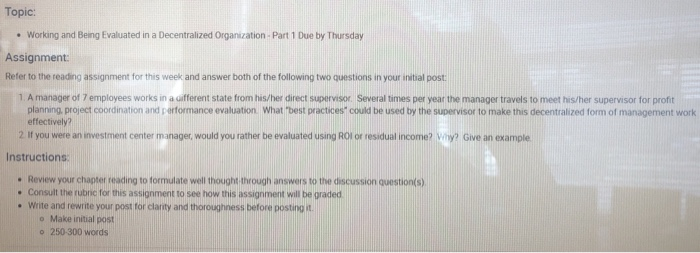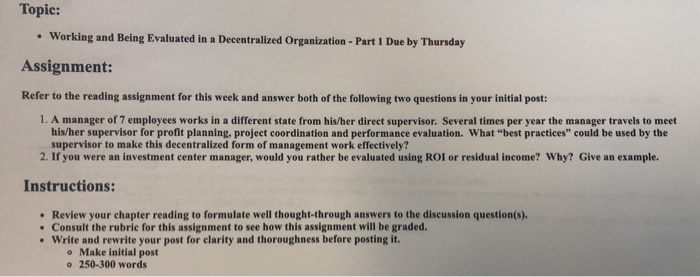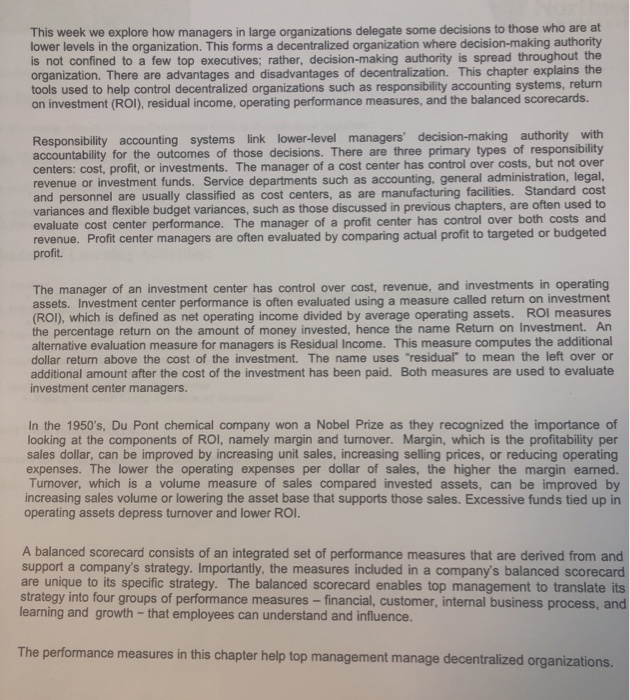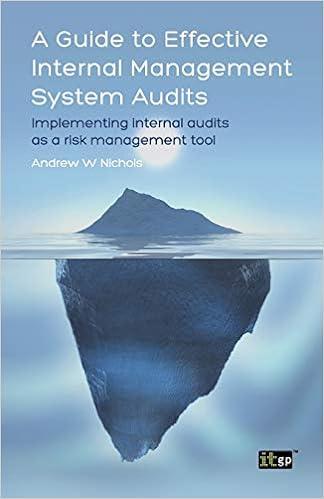Topic: Working and Being Evaluated in a Decentralized Organization - Part 1 Due by Thursday Assignment: Refer to the reading assignment for this week and answer both of the following two questions in your initial post 1. A manager of 7 employees works in a cifferent state from his/her direct supervisor Several times per year the manager travels to meet his/her supervisor for profit planning, project coordination and performance evaluation. What best practices could be used by the supervisor to make this decentralized form of management work effectively 2. If you were an investment center manager, would you rather be evaluated using ROI or residual income? Viw? Give an example, Instructions Review your chapter reading to formulate well thought through answers to the discussion question(s) Consult the rubne for this assignment to see how this assignment will be graded Write and rewrite your post for clarity and thoroughness before posting it . Make initial post o 250-300 words Topic: Working and Being Evaluated in a Decentralized Organization - Part 1 Due by Thursday . Assignment: Refer to the reading assignment for this week and answer both of the following two questions in your initial post: 1. A manager of 7 employees works in a different state from his/her direct supervisor. Several times per year the manager travels to meet his/her supervisor for profit planning, project coordination and performance evaluation. What "best practices" could be used by the supervisor to make this decentralized form of management work effectively? 2. If you were an investment center manager, would you rather be evaluated using ROI or residual income? Why? Give an example. Instructions: Review your chapter reading to formulate well thought through answers to the discussion question(s). Consult the rubric for this assignment to see how this assignment will be graded. Write and rewrite your post for clarity and thoroughness before posting it. o Make initial post o 250-300 words This week we explore how managers in large organizations delegate some decisions to those who are at lower levels in the organization. This forms a decentralized organization where decision-making authority is not confined to a few top executives; rather, decision-making authority is spread throughout the organization. There are advantages and disadvantages of decentralization. This chapter explains the tools used to help control decentralized organizations such as responsibility accounting systems, return on investment (ROI), residual income, operating performance measures, and the balanced Scorecards. Responsibility accounting systems link lower-level managers' decision-making authority with accountability for the outcomes of those decisions. There are three primary types of responsibility centers: cost, profit, or investments. The manager of a cost center has control over costs, but not over revenue or investment funds. Service departments such as accounting, general administration, legal, and personnel are usually classified as cost centers, as are manufacturing facilities. Standard cost variances and flexible budget variances, such as those discussed in previous chapters, are often used to evaluate cost center performance. The manager of a profit center has control over both costs and revenue. Profit center managers are often evaluated by comparing actual profit to targeted or budgeted profit. The manager of an investment center has control over cost, revenue, and investments in operating assets. Investment center performance is often evaluated using a measure called return on investment (ROI), which is defined as net operating income divided by average operating assets. ROI measures the percentage return on the amount of money invested, hence the name Return on Investment. An alternative evaluation measure for managers is Residual Income. This measure computes the additional dollar return above the cost of the investment. The name uses "residual to mean the left over or additional amount after the cost of the investment has been paid. Both measures are used to evaluate investment center managers. In the 1950's, Du Pont chemical company won a Nobel Prize as they recognized the importance of looking at the components of ROI, namely margin and turnover. Margin, which is the profitability per sales dollar, can be improved by increasing unit sales, increasing selling prices, or reducing operating expenses. The lower the operating expenses per dollar of sales, the higher the margin earned. Turnover, which is a volume measure of sales compared invested assets, can be improved by increasing sales volume or lowering the asset base that supports those sales. Excessive funds tied up in operating assets depress turnover and lower ROI. A balanced Scorecard consists of an integrated set of performance measures that are derived from and support a company's strategy. Importantly, the measures included in a company's balanced Scorecard are unique to its specific strategy. The balanced Scorecard enables top management to translate its strategy into four groups of performance measures - financial, customer, internal business process, and learning and growth - that employees can understand and influence. The performance measures in this chapter help top management manage decentralized organizations. Topic: Working and Being Evaluated in a Decentralized Organization - Part 1 Due by Thursday Assignment: Refer to the reading assignment for this week and answer both of the following two questions in your initial post 1. A manager of 7 employees works in a cifferent state from his/her direct supervisor Several times per year the manager travels to meet his/her supervisor for profit planning, project coordination and performance evaluation. What best practices could be used by the supervisor to make this decentralized form of management work effectively 2. If you were an investment center manager, would you rather be evaluated using ROI or residual income? Viw? Give an example, Instructions Review your chapter reading to formulate well thought through answers to the discussion question(s) Consult the rubne for this assignment to see how this assignment will be graded Write and rewrite your post for clarity and thoroughness before posting it . Make initial post o 250-300 words Topic: Working and Being Evaluated in a Decentralized Organization - Part 1 Due by Thursday . Assignment: Refer to the reading assignment for this week and answer both of the following two questions in your initial post: 1. A manager of 7 employees works in a different state from his/her direct supervisor. Several times per year the manager travels to meet his/her supervisor for profit planning, project coordination and performance evaluation. What "best practices" could be used by the supervisor to make this decentralized form of management work effectively? 2. If you were an investment center manager, would you rather be evaluated using ROI or residual income? Why? Give an example. Instructions: Review your chapter reading to formulate well thought through answers to the discussion question(s). Consult the rubric for this assignment to see how this assignment will be graded. Write and rewrite your post for clarity and thoroughness before posting it. o Make initial post o 250-300 words This week we explore how managers in large organizations delegate some decisions to those who are at lower levels in the organization. This forms a decentralized organization where decision-making authority is not confined to a few top executives; rather, decision-making authority is spread throughout the organization. There are advantages and disadvantages of decentralization. This chapter explains the tools used to help control decentralized organizations such as responsibility accounting systems, return on investment (ROI), residual income, operating performance measures, and the balanced Scorecards. Responsibility accounting systems link lower-level managers' decision-making authority with accountability for the outcomes of those decisions. There are three primary types of responsibility centers: cost, profit, or investments. The manager of a cost center has control over costs, but not over revenue or investment funds. Service departments such as accounting, general administration, legal, and personnel are usually classified as cost centers, as are manufacturing facilities. Standard cost variances and flexible budget variances, such as those discussed in previous chapters, are often used to evaluate cost center performance. The manager of a profit center has control over both costs and revenue. Profit center managers are often evaluated by comparing actual profit to targeted or budgeted profit. The manager of an investment center has control over cost, revenue, and investments in operating assets. Investment center performance is often evaluated using a measure called return on investment (ROI), which is defined as net operating income divided by average operating assets. ROI measures the percentage return on the amount of money invested, hence the name Return on Investment. An alternative evaluation measure for managers is Residual Income. This measure computes the additional dollar return above the cost of the investment. The name uses "residual to mean the left over or additional amount after the cost of the investment has been paid. Both measures are used to evaluate investment center managers. In the 1950's, Du Pont chemical company won a Nobel Prize as they recognized the importance of looking at the components of ROI, namely margin and turnover. Margin, which is the profitability per sales dollar, can be improved by increasing unit sales, increasing selling prices, or reducing operating expenses. The lower the operating expenses per dollar of sales, the higher the margin earned. Turnover, which is a volume measure of sales compared invested assets, can be improved by increasing sales volume or lowering the asset base that supports those sales. Excessive funds tied up in operating assets depress turnover and lower ROI. A balanced Scorecard consists of an integrated set of performance measures that are derived from and support a company's strategy. Importantly, the measures included in a company's balanced Scorecard are unique to its specific strategy. The balanced Scorecard enables top management to translate its strategy into four groups of performance measures - financial, customer, internal business process, and learning and growth - that employees can understand and influence. The performance measures in this chapter help top management manage decentralized organizations









